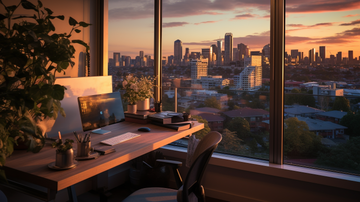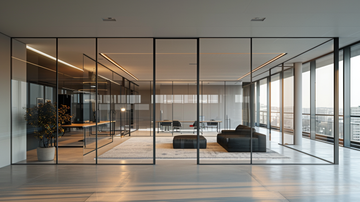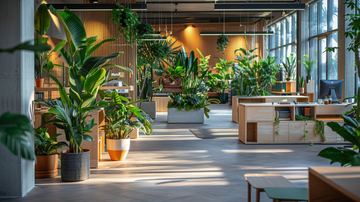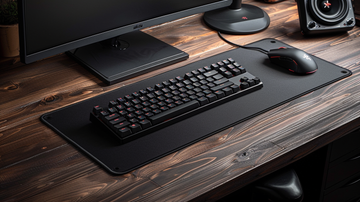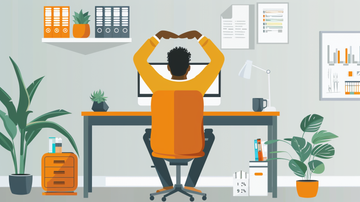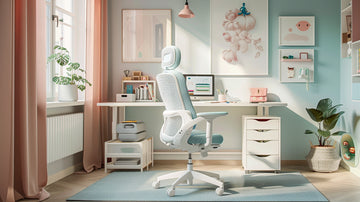Introduction
The COVID-19 pandemic has dramatically accelerated the remote work trend. According to FlexJobs, the number of people working remotely has grown by over 159% since 2005. In a recent survey, nearly 60% of full-time workers said they would look for a new job if they were not provided with flexible remote work options.
With more people working from home than ever before, optimizing your home office design has become increasingly important for productivity and comfort. The right home office setup can help remote workers stay focused, organized, and energized throughout the workday. In this blog post, we will provide tips to design an ergonomic, functional, and aesthetically pleasing home office space.
Define Your Needs
When setting up your home office, the first step is to define how you will use the space. Consider what types of tasks and activities you will regularly perform. This will help determine the layout, furniture, and equipment needed.
For example, if you frequently have video calls, make sure there is adequate lighting and a suitable background. Position your desk so the camera angle is flattering. Reduce background noise by closing windows and doors during calls.
If you need to focus for long periods, choose a quiet location away from household distractions. Invest in a comfortable chair and footrest so you can sit for extended times. Add plants or decor to make the space visually appealing.
For meetings and collaboration, pick a roomy area that can fit multiple people. Use a large desk or conference table. Provide seating with good back support. Make sure there are sufficient power outlets and strong WiFi connectivity.
Analyzing your needs will enable you to create a functional and productive home office environment catered to your work style.
Lighting
Lighting is a critical component of any home office. The right lighting can help reduce eye strain, improve focus and productivity, and create a pleasant workspace. When designing a home office, it's important to consider both natural and artificial lighting options.
Natural light is ideal for a home office when available. Situating your desk near a window allows daylight to illuminate your workspace. Natural light reduces eyestrain and has been shown to boost mood, focus and productivity (https://www.lightopia.com/home-office-lighting-ideas). If possible, avoid having the window directly behind your monitor, as this can cause glare on the screen.
Supplement natural light with adjustable artificial lighting. Many lighting experts recommend using layered lighting for a home office, with ambient, task, and accent lighting (https://www.posturite.co.uk/home-office/home-office-lighting-tips). Ambient lighting provides overall illumination, while task lighting focuses light directly on your work area. Accent lighting adds visual interest to the space.
For task lighting, opt for an adjustable desk lamp that lets you direct light where you need it. Look for bulbs that provide bright, white light at a color temperature around 5000K-6500K. Position the lamp to avoid glare on your monitor. Undercabinet lighting is another good option for focused task lighting.
Make sure to also have ambient lighting in the room, such as recessed ceiling lights, chandeliers or wall sconces. Dimmer switches allow you to control the brightness as needed. Automatic daylight dimmers can supplement natural light throughout the day.
With the right mix of natural and artificial lighting, you can create the perfect illuminated environment for your home office.
Ergonomic Furniture
Choosing the right ergonomic furniture is crucial for setting up a comfortable and productive home office. Investing in an ergonomic desk and chair designed to support proper posture can help reduce muscle strain, fatigue, and pain that can come from sitting for long periods. An ergonomic workspace helps you maintain good posture and allows your body to move naturally while typing and working on the computer.
An adjustable height desk is ideal, as standing periodically throughout the day is healthier than sitting for 8+ hours. Look for a desk that allows you to alternate between sitting and standing positions. An ergonomic desk chair should provide lumbar support for your lower back, allow your feet to rest flat on the floor, and have adjustable features like seat height, armrests, and tilt tension. High-end brands like Eureka Ergonomic and Relax The Back offer a range of quality ergonomic desks and chairs to suit different needs and budgets.
Investing in proper ergonomic furniture helps you maintain better posture and joint health as you work. This can boost comfort, productivity, and prevent repetitive strain injuries that can come from long hours hunched over a computer.
Storage
Having proper storage in your home office is key to maintaining an organized and productive workspace. Invest in organizational systems like shelves, cabinets, and desktop accessories to keep supplies tidy and within reach. According to The Spruce, woven bins are an easy way to corral small items like pens, paper clips, and more (Source). For larger supplies, installing shelving along the walls provides open storage. Opt for shelving units with adjustable shelves so you can customize to fit your needs. Stackable storage cubes also offer modular and customizable storage for files, books, and more.
For important documents and other items you want to keep secure, look into filing cabinets. Vertical filing cabinets have a small footprint and fit nicely against a wall. Lateral filing cabinets provide more drawer space while taking up more floor space. If you have the room, The Balance Careers recommends a credenza with a filing cabinet built in for ample concealed storage (Source). Place frequently used items within arm's reach, while keeping less commonly used supplies in farther storage. This creates an efficient workflow.
Minimize Clutter
Clutter can be distracting and make it difficult to focus while working. Here are some tips for decluttering your workspace:
Go through all the piles of paper and files and sort them into keep, toss, or file categories. Only keep what you absolutely need for current or upcoming projects. Anything else can likely be tossed or filed away. (Source)
Get rid of unused office supplies. Take an inventory and donate or recycle anything you don't need. This clears up drawer space for items you actually use. (Source)
Store infrequently used items like extra electronics, files, or seasonal supplies elsewhere, not on your desk. This clears up workspace and reduces visual clutter.
Use organizational systems like file cabinets, trays, or desktop organizers to neatly store essential items within reach.
Schedule time weekly or monthly to tidy your workspace and prevent clutter from accumulating again.
Plants
Adding plants to your home office can provide many benefits beyond simply decorating the space. Studies have shown that having plants in an office environment can increase productivity, reduce stress, and improve air quality.
One study found that employees working in offices with plants scored higher on tests of memory retention and attentiveness than those in plant-free offices (source). Plants help create a more relaxing environment by adding color, nature, and life to an otherwise sterile office. This can lower stress levels and improve mood.
Plants also increase oxygen levels through photosynthesis while reducing air pollutants like carbon dioxide and formaldehyde (source). Better air quality means better breathing and less drowsiness during long work hours. Studies show that proper air humidity provided by plants is optimal for human health and productivity.
When selecting plants, opt for low-maintenance varieties that don't require frequent watering or pruning. Snake plants, pothos, succulents, and zz plants are great options that can thrive with just moderate sunlight. Place plants in corners, on shelves, or near windows to bring nature's benefits to your workspace.
Wall Decor
Wall decor is an important element in a home office design. It can help make the space feel more lively and personalized. When selecting wall decor for a home office, there are a few key factors to consider:
Framed art like paintings, prints or photographs help add visual interest to blank walls. Go for pieces that reflect your style and personality. A gallery wall with a collection of framed art creates an eye-catching focal point. Arrange the pieces in an aesthetically pleasing layout for maximum impact.
Bulletin boards are functional for posting reminders, photos, calendars and more. Cork boards are ideal for push pins while whiteboards allow you to write messages that can be easily erased and changed. Locate them in a high visibility area.
Wall decor doesn't have to be expensive. Use creative touches like wall decals, decorative tape, framed quotes or memorabilia to inject personality. Just be sure the items relate to your interests and the office's purpose.
No matter what wall decor you choose, go for pieces you love. Wall decor is one of the easiest ways to make your home office space feel like an inspiring, enjoyable place to work in.
Noise Control
Working from home comes with its fair share of noise distractions. Whether it's neighbors, traffic, kids, or pets, ambient noise can severely impact your focus and productivity. Here are some tips for minimizing distractions and noise in your home office:
Use noise-blocking curtains on your windows. Thick, layered curtains can help muffle outside noise from traffic, construction, etc. Look for curtains made of sound-absorbing materials like velvet or wool.
Seal any cracks or gaps around doors and windows with weatherstripping. This prevents outside noise from seeping in through small openings.
Install acoustic panels on your walls. These sound-absorbing panels help prevent echoes and reduce reverberation of noise within your office space. Panels made of foam or fiberglass work best.
Use a white noise machine or app. Soothing sounds like rainfall, ocean waves, or ambient noise can help mask distracting sounds around you.
Wear noise-cancelling headphones when you need to focus. Noise-cancelling headphones use technology to block out ambient noise.
Ask family members to avoid loud activities near your workspace during work hours. Communication and planning can help minimize disruptions.
Take regular breaks outside your office space. Getting away from the noise completely can be refreshing.
With some planning and a few upgrades, you can create a peaceful oasis amid the noise of home. A quiet space will help you stay focused and productive.
Sources:
https://www.quill.com/blog/how-to-reduce-noise-in-your-home-office/
https://www.soundproofcow.com/soundproofing-work-from-home/
Conclusion
In summary, there are many elements to consider when designing your ideal home office. Proper lighting, ergonomic furniture, and storage solutions will help maximize your comfort and productivity. Don't forget to add some personal touches like plants, wall art, and other decor to make the space feel like your own.
Here are some final tips for your home office:
- Invest in a quality office chair - it's worth it for your health.
- Get a monitor riser or laptop stand to elevate your screen.
- Add sound absorbing materials if noise is an issue.
- Keep your desk facing away from windows to avoid glare.
- Organize cables and cords so they don't clutter your workspace.
- Take breaks, stretch, and change positions frequently when working long hours.
With some planning and organization, your home office can be an inspiring and productive workspace. The most important thing is creating an environment tailored to your needs and style.

